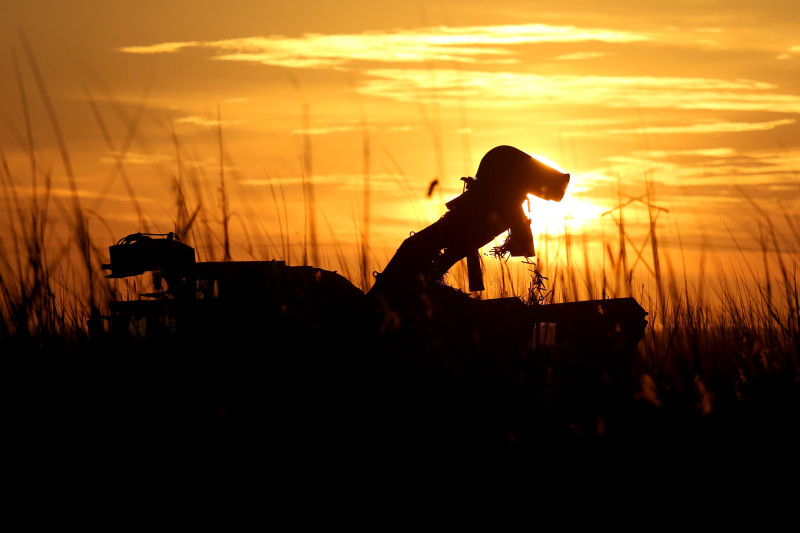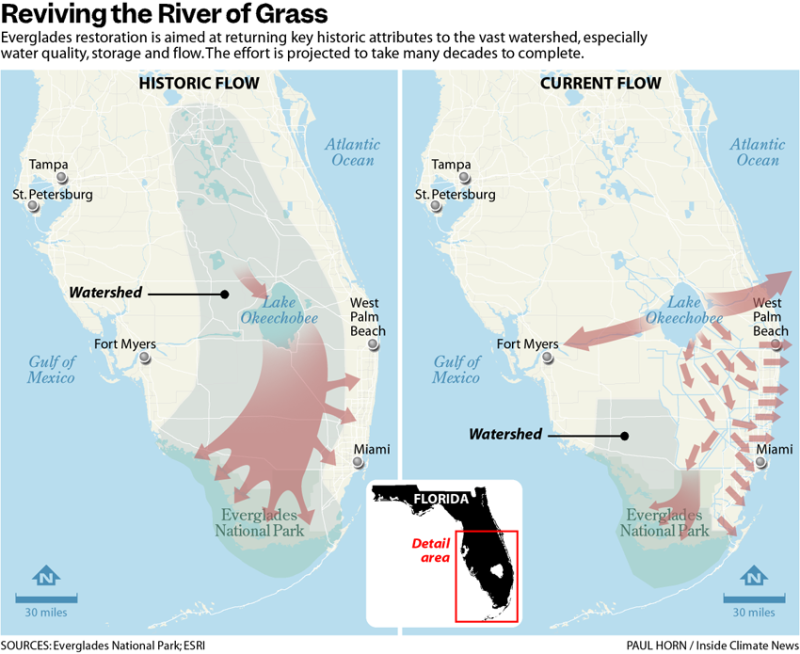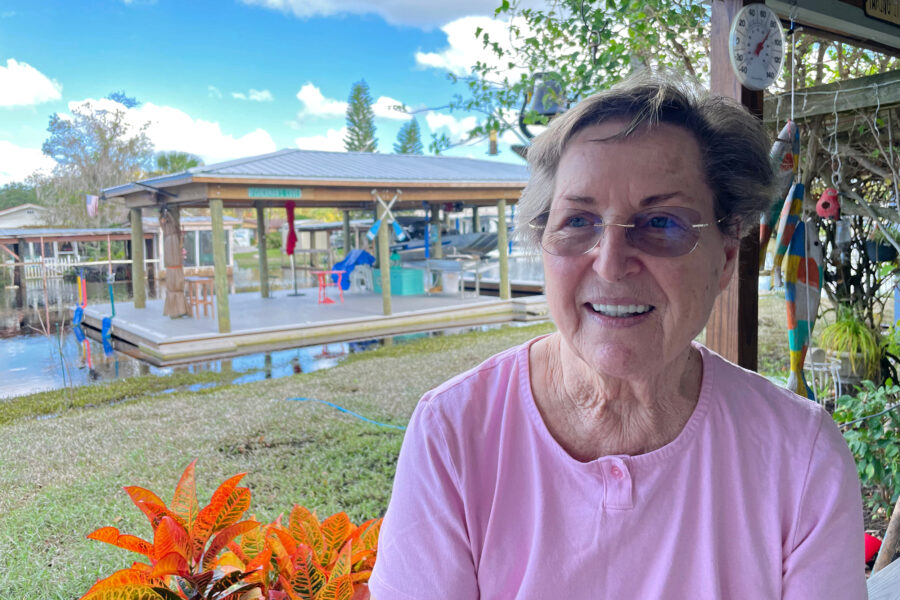Billions of Gallons of Freshwater Are Dumped at Florida’s Coasts. Environmentalists Want That Water in the Everglades
Scattered between the vast sugar cane and vegetable fields of Florida’s heartland and the fragile marshes of the Everglades are a series of wetlands, resembling nature but hardly natural, that together represent the largest experiment of its kind in the world.
The wetlands were built over the last 30 years to serve as a buffer between the farms that make the region south of Lake Okeechobee among the nation’s most bountiful and the Everglades, where a $21 billion restoration effort is one of the most ambitious of its kind in human history.
Spanning some 62,000 acres, the wetlands are composed of cattails, southern naiad and other plant species that function as natural water filters, the vegetative tissues absorbing pollution flowing from the farms that would threaten the river of grass. Nowhere else on Earth have human-made wetlands such as these ever been implemented on such an expansive scale.
Called stormwater treatment areas (STAs) in the bureaucratic parlance of Everglades restoration, the wetlands now are at the heart of a new controversy over a calamity elsewhere in the watershed, which encompasses much of the peninsula and is responsible for the drinking water of some 9 million Floridians. That calamity begins in Lake Okeechobee.
We’re hiring!
Please take a look at the new openings in our newsroom.
See jobsEvery day some 1.7 billion gallons of freshwater that once spilled over the southern shore of the state’s largest lake, flowing eventually into the sawgrass prairies of the river of grass, are instead drained through a series of canals and out to sea.
The amount is more than that consumed in South Florida daily, and during times of high water the state’s flood control procedures require that even more freshwater be dumped at the coasts. This spring, at least 156 billion gallons of freshwater were discharged from the lake during a six-week span, according to the U.S. Army Corps of Engineers. Water managers sought to bring down the lake, still swollen after Hurricane Ian dropped historic amounts of rain here in 2022, ahead of hurricane season, which began June 1.
The waste of so much freshwater would be problem enough as Florida’s population booms and climate change and sea level rise pressure the fragile Everglades, the state’s most important freshwater resource. But the lake releases also can overwhelm delicate coastal estuaries to the east and west of the lake and, during the warm summer months, spread blooms of toxic algae from the lake.
The noxious blooms have choked rivers, sullied beaches, sickened Floridians and left wildlife belly-up. The issue has become one of the most prominent facing the state in recent years and helped shape the environmental policy of Gov. Ron DeSantis, a former Republican presidential candidate, prompting him to invest billions of dollars in Everglades restoration.
“What we are doing, it’s just so irresponsible,” said Jacqui Thurlow-Lippisch, a sixth-generation Floridian and former mayor of Sewall’s Point, a community some 43 miles north of West Palm Beach that has been especially hard-hit by the toxic algae.
“It’s like throwing money out the car window,” she said of the lake discharges. “It’s absolutely disrespectful for our most important resource, water.”
Residents of the coastal communities that have experienced the worst blooms and environmental groups engaged in Everglades restoration want water managers to address the lake releases and harmful algae by using the stormwater treatment areas.
They want more lake water distributed south through the wetlands, in the direction the water once flowed, rather than in the unnatural pattern that moves water east and west. Now, most of the water moving through the stormwater treatment areas originates from the Everglades Agricultural Area (EAA), as the region south of Lake Okeechobee is called. Here the primary crop is sugar cane; Florida is the country’s top producer of the crop.
The coastal residents and environmental groups see this disparity of water flowing through the stormwater treatment areas as yet another symptom of the commanding grip the state’s politically powerful sugar growers wield over the water management infrastructure here.
“We are still living with an antiquated, outdated water management system that puts a heavily protected crop, sugar cane, above the broader needs of the public, the environment, our economy,” said Eve Samples, executive director of Friends of the Everglades. “We’ve been calling it a rigged system, but I don’t think it’s going too far to call it corruption.”
“If taxpayers were aware of it I think there would be a rebellion. I really do. It’s immoral,” said Thurlow-Lippisch, a former board member for the South Florida Water Management District, the state agency overseeing Everglades restoration. “It is not 1948. Women are not in the kitchen anymore. We have desegregated our schools, thank God. We cannot live in a time where the agricultural community today runs the Legislature and puts everything in their favor at the expense of our environment and taxpaying citizens, and that is what is happening.”
The South Florida Water Management District says its water managers are sending as much water south as they can.
“Federally required flood control for communities and businesses must occur as a primary purpose,” according to a statement the water management district provided to Inside Climate News. “Because there is now a federal consent decree and federal permits requiring that water entering the Everglades is clean, the District is required to use the Stormwater Treatment Areas to pull water from canals in the EAA to provide flood control.”

Meanwhile Florida’s sugar growers, the largest of which is responsible for nearly 10 percent of all the sugar produced in the country, say the point of the stormwater treatment areas always has been to treat their own water pollution, not accommodate water from Lake Okeechobee.
The sugar growers say the strategy has worked so well there is no reason to change now, and that doing so could jeopardize the wetlands’ efficacy. They say the focus instead should be on implementing Everglades restoration projects that can address the harmful lake releases by enhancing water storage and treatment, according to a statement provided to Inside Climate News by the industry in the state.
“I was there from the beginning,” said Ernie Barnett, executive director of the Florida Land Council, a nonprofit whose members include U.S. Sugar Corp. and Florida Crystals Corp. Barnett also is a former assistant executive director at the South Florida Water Management District, where he oversaw Everglades restoration. “This is what I live and breathe, and I can tell you it’s real clear to me in the law and it’s real clear to me in the permits.”
“This idea that you can just simply send lake water down into the Everglades as a relief valve doesn’t work,” he said.
Too Much Water
In a state showered with some 50 inches of rain annually one might imagine there should be more than enough water to go around, and everyone would be happy.
Florida’s problem is that there is too much water. The ample rain falls on a state where much of the infrastructure has been designed to carry water off the landscape as efficiently as possible, to make way for the explosive growth and development, and also, south of Lake Okeechobee, some 700,000 acres of crops, most notably sugarcane.
No longer do the Everglades flow freely. Today some 2,200 miles of canals, 2,100 miles of levees and berms, 84 pump stations and 778 water control structures sustain the river of grass, which has been drained to a fraction of its former self. The watershed begins in central Florida with the headwaters of the Kissimmee River and includes Lake Okeechobee, sawgrass marshes to the south and Florida Bay, at the peninsula’s southernmost tip.
The stormwater treatment areas represent one component of Everglades restoration, which involves a series of landscape-scale projects, each massive on its own. Together the projects are designed to recapture the water drained from the peninsula and also revive key historic attributes of the river of grass, especially water quality, storage and flow.
At the center of the controversy over the stormwater treatment areas are several layers of federal court actions and state laws dating to the 1980s, when the federal government sued the state over the sugar growers’ water pollution, which was threatening protected areas of the Everglades. The litigation would culminate in a dramatic moment in 1991 when then-Gov. Lawton Chiles, a Democrat, admitted in a Miami courtroom that the water was dirty, and the state was responsible.
“I am here, and I brought my sword,” he said. “I want to find out who I can give my sword to!”
Eventually the litigation would lead to a consent decree, and in 1994, the state Legislature approved the Everglades Forever Act, which called for “comprehensive and innovative solutions to issues of water quality,” including the stormwater treatment areas.
The law also required sugar growers to address their own pollution by implementing so-called best-management practices, a series of measures including altering fertilizer techniques, controlling soil erosion and increasing onsite water retention. The law also imposed an agricultural tax on sugar growers operating within the EAA, to help pay for the construction of the stormwater treatment areas and eventually their operation.
“Whenever possible, wasteful discharges of fresh water to tide shall be reduced, and the water shall be stored for delivery at more optimum times,” the law stated, although it did not specify where the water should be stored or how the discharges should be reduced.
The law also authorized the South Florida Water Management District to initiate a so-called Everglades Construction Project, which the measure characterized as “by far the largest environmental cleanup and restoration program of this type ever undertaken.” The project was separate from a larger restoration effort then-President Bill Clinton signed into law in 2000.
The project was described in detail in a separate document, which specified how the wetlands should be managed. As an example, the document stated that stormwater treatment area No. 6, situated south of the Everglades Agricultural Area, should treat water flowing from an 11,200-acre expanse owned by U.S. Sugar, Florida’s largest sugar grower.

Directing more lake water through the wetlands not only would be at odds with the federal court actions and state laws governing them, Barnett said. It also would be harmful to the Everglades, which today are much smaller than they used to be. While restoration is aimed at replenishing the watershed, many of the projects will not be complete for several years.
“You’ll drown the Everglades. We’ve always known that,” he said. “The STAs were all designed, permitted and accepted by the courts as the framework for how ultimately the state water quality standard would be met.”
The environmental groups say more water could be held within the EAA, by raising the water table or cultivating more water-tolerant crops.
They say the federal court actions and state laws exist within a bigger picture, one that has changed somewhat since the Everglades Forever Act was enacted but still consists of many of the same unjust components that existed some 30 years ago.
Where water once spilled over Lake Okeechobee’s southern shore are now countless rows of sugar cane, made possible by a U.S. Army Corps of Engineers effort to drain the Everglades and a federal price support system that boosts the price of sugar, all supported by taxpayers.
The infrastructure at the heart of the Army Corps effort, some of the most complex in the world, was designed in large part to accommodate the EAA’s location south of the lake, because of the fertile soil here. The cane fields, green and vast beneath a blue dome of sky, also require that the water be managed on an upside-down schedule so that the fields are irrigated during the dry season and drained during the wet season.
The sugar growers curry favor with the state’s top lawmakers as one of the most generous special interest groups in agribusiness, with Florida Crystals giving more than $1 million toward federal campaigns so far during the 2024 election cycle and U.S. Sugar contributing $555,000.
Meanwhile, the state has invested some $2 billion toward the stormwater treatment areas’ construction to address the sugar growers’ pollution, even as the state also grapples with the scourge of toxic algae. Five conservation groups and the city of Stuart petitioned the Environmental Protection Agency last month to set standards under the Clean Water Act for the algae toxins, which have been linked to liver and neurodegenerative diseases.
“The toxic algae, it is poisonous,” Thurlow-Lippisch said. “When it is in your waters it is in your air. It is affecting your health. It is affecting the wildlife. Children cannot safely go outside and run around. Children cannot go to their camps.”
“We have the right to say, ‘Why isn’t it 50-50?’”
The environmental groups say the web of federal court actions and state laws is not entirely clear when it comes to how the stormwater treatment areas should be managed.
“People who want to say that no more water from Lake Okeechobee can be routed to the STAs because of this phrase or that phrase are cherry-picking,” said Ansley Samson, general counsel at the Everglades Law Center, a nonprofit law firm. “Those documents say lots of things including that we should do more to reduce Lake Okeechobee regulatory discharges.”
The groups also say the South Florida Water Management District similarly has not provided much clarity on why the wetlands are operated this way. In 2021 and 2022, less than 11 percent of the water moving through the stormwater treatment areas was from Lake Okeechobee, and in 2023, it was less than four percent.
“… if you’re not adapting you’re not surviving.”
By contrast, in 2015, nearly half of the water in the wetlands was from the lake. The groups cite this kind of variation as evidence that it is possible to move more lake water through the stormwater treatment areas. The water management district declined to elaborate on this issue beyond the statement provided to Inside Climate News.
“There is nowhere where the South Florida Water Management District has been able to convince the public that the STAs are only for the EAA and not for Lake Okeechobee water, as well as there is nowhere that is written,” said Thurlow-Lippisch, who served on the board for the water management district from 2019 to 2023. “We have the right to say, ‘Why isn’t it 50-50?’ Or ‘Why isn’t it 30-70?’ Instead of basically 10-90.”
“It’s built into the fabric of the culture,” she said. “It’s not wrong to them. It’s been like this. It’s how it is. But the bottom line is, if you’re not adapting you’re not surviving. So what we’re doing, we’re putting the rest of Florida in a position where we’re not surviving the same way agriculture is.”
“It seems to be up to their discretion on how to operate these things as far as I can tell so far, and we’re trying to get a clear understanding of that,” said Mark Perry, executive director and chief executive officer of the Florida Oceanographic Society, an advocacy group.
The Work Will Not End
The miracle of the Everglades was their simplicity. The watershed was born of sunlight, rain and little else, and flourished because of a unique paucity of life-giving nutrients, a situation that hindered the pursuit of any single species that would take over all the rest.
This changed with the introduction of the growth and development that has characterized modern Florida and also the vast cane fields of the EAA, whose farmers applied nutrient-rich fertilizers to their crops. The fertilizers engorged the Everglades with nutrients, most notably phosphorus, leading to a widespread proliferation of cattails. By the late 1980s, the river of grass was at risk of becoming something else entirely, a river of cattails.
The stormwater treatment areas were designed to replicate the natural filtering ability of the Everglades, and the grand experiment largely has worked. The South Florida Water Management District, in its statement to Inside Climate News, said the wetlands now have treated some 8.7 trillion gallons of water, reducing the amount of phosphorus flowing into protected areas of the Everglades by some 77 percent.
The wetlands have been expanded over the last decade under additional state legislation and also, in 2012, an agreement with the EPA. That agreement called for more than 6,500 new acres of stormwater treatment areas and more water storage. Together with the sugar growers’ best-management practices, the water pollution has declined at a rate that is more than double that mandated by state law, according to the water management district. Today, at least 90 percent of the Everglades’ water meets the state standard.
“This is an unparalleled success story of farmers working with government,” Barnett said, “unmatched anywhere else in the world, and it should be celebrated.”
“Yes, they’ve improved their pollution with the help of the district, which does almost all of the work,” Thurlow-Lippisch said.
Even after construction is complete on the stormwater treatment areas, the work of managing them will not end. The weather and wildlife can affect the filtering plants. Hurricanes can rip out the vegetation and stir up sediments. Ongoing mechanical repairs and maintenance are needed on the more than two dozen pump stations, 350 water control structures and more than 600 miles of levees and canals used to operate the wetlands. Constant water monitoring is necessary to ensure the wetlands are functioning properly, and the data form the basis of operational decisions.
The U.S. Army Corps of Engineers is poised to implement new rules this year for managing Lake Okeechobee that many hope will provide more flexibility when it comes to how much water is held within the lake and where it is dispersed. Samples said the plan is the first to acknowledge the risks of toxic algae and establish a southerly flow as a priority, but that more stormwater treatment areas would be necessary to accommodate the water.
Construction also is underway on a 16-square-mile reservoir in the EAA, the largest of its kind the Army Corps ever has built. The project, which includes yet another stormwater treatment area, is aimed at cleaning and conveying more water south, although some of the environmental groups have raised concerns about the reservoir’s design.
The groups fear the new infrastructure will not distribute enough water south or filter the water to the established standard. They say the reservoir’s 23-foot depth is excessive and could provide another place for toxic algae to bloom. They also argue the design has failed to account for climate change. Construction is scheduled to be complete in 2030.
“The really bigger bottom line, we know we still need more land for more STAs if the sugar cane industry is going to continue farming in the EAA,” Samples said. “We have to demand that this vice grip that the sugar cane industry has on our water system is removed.”
Share this article
Disclaimer: The copyright of this article belongs to the original author. Reposting this article is solely for the purpose of information dissemination and does not constitute any investment advice. If there is any infringement, please contact us immediately. We will make corrections or deletions as necessary. Thank you.







